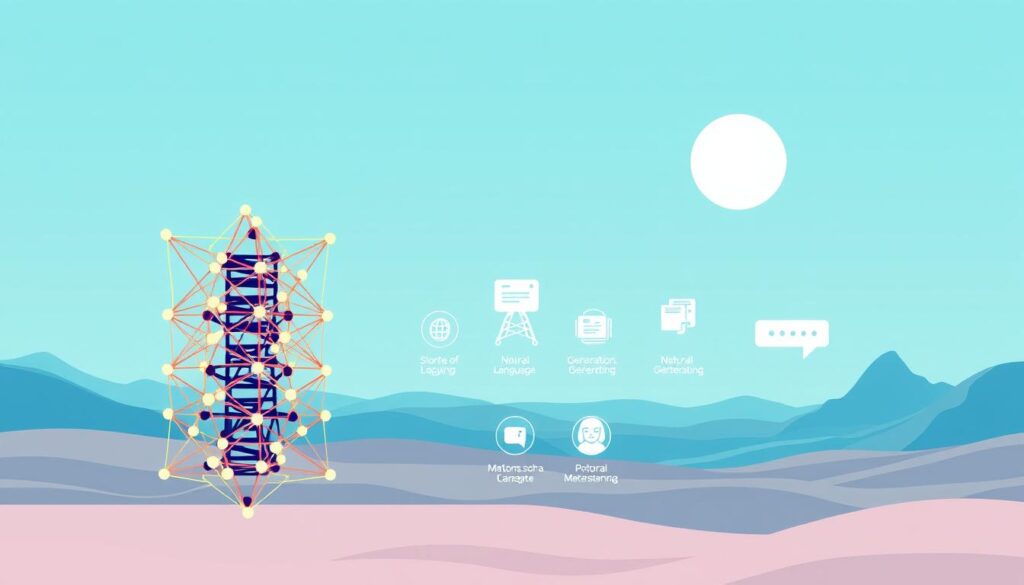The digital world is changing fast. Artificial Intelligence (AI) is leading this change. As a content creator, I always look for new ways to stay ahead.
Large Language Models (LLMs) are advanced AI systems. They are trained to understand, generate, and interact in human language. This tech could change how we make and use content.
As we move into 2025, knowing how LLMs work is key. It helps content creators use this tech to get better at their jobs. This way, they can stay ahead in the digital world.
Key Takeaways
- LLMs are advanced AI systems that can understand and generate human language.
- Content creators can benefit from using LLMs to improve their work.
- Understanding LLMs is important for staying competitive in 2025.
- LLMs have the power to change the content creation process.
- Knowing about LLMs helps you stay ahead in 2025.
The AI Revolution in Content Creation
In 2025, the world of making content is changing fast. AI writing tools are making it easier to create great content quickly.
The Rapid Evolution of AI Writing Tools
AI tools can make all sorts of content, like blog posts and product descriptions. They can even write emails and reports. This saves a lot of time and makes sure everything sounds the same.
For example, AI can write articles and marketing stuff that’s both fun and useful.
Why 2025 Is a Pivotal Year for Content Creators
In 2025, AI will keep getting better, making it a big year for creators. Now, businesses can have instant 24/7 customer support with smart chatbots. This makes customers happier and more loyal.
As AI tools get smarter, creators need to keep up to stay ahead.
What Is an LLM? Understanding the Basics
First, let’s learn what LLMs are and how they work. Large Language Models (LLMs) are smart machines that understand and make human-like language. They learn from lots of text, getting better at patterns, grammar, and meaning.
Definition and Core Concepts
LLMs use deep learning and are trained on huge amounts of words. They can do many things, like answer questions and make content. You might know ChatGPT, Gemini, and Llama as examples of LLMs.
These models can write like humans. They are very good at many things. Andrew Ng says AI is like electricity, changing many fields.
How LLMs Differ from Traditional AI
LLMs are different from old AI because they can do many things. They don’t need special training for each task. They learn from lots of text and answer like humans.
LLMs use special tech to understand and answer. This tech helps them get the point of what they’re told and respond well.
| Feature | Traditional AI | LLMs |
|---|---|---|
| Task Specificity | Designed for specific tasks | General-purpose, can handle a wide range of tasks |
| Training Data | Task-specific training data | Trained on vast amounts of text data |
| Response Generation | Limited to predefined responses | Can generate human-like responses |
Knowing about LLMs is key for creators. With GPT-4 and others, the possibilities are endless.

How LLMs Work: The Technical Foundation
LLMs use neural networks, training data, and special algorithms. To get how they work, we need to look at these key parts.
The Neural Network Architecture
LLMs have a neural network architecture that’s like the human brain. It helps them understand and make language. This makes their text seem very human.
Training Data and Pattern Recognition
LLMs learn from a huge amount of text. This text helps them find patterns and word relationships. Experts say, “Good training data makes LLMs better.”
The Role of Transformers and Attention Mechanisms
Transformers and attention mechanisms are key for LLMs. They help LLMs focus on important parts of text. This makes their output more accurate and relevant. Models like Claude use these to perform very well.
Tokens, Embeddings, and Prediction
Text generation starts with breaking text into tokens. Then, these tokens become embeddings. LLMs use these to guess the next word. This guessing is based on what they learned from training.
Open-source LLMs are trying new things with tokens and embeddings. This makes them even better.
In short, knowing how LLMs work is important. It helps us see what they can do and what they can’t. By understanding neural networks, training data, and special algorithms, we can use LLMs better in our work.
The Major Players in the LLM Space
The world of LLMs is very competitive. OpenAI’s GPT-4 and Anthropic’s Claude are at the top. It’s important for content creators to know who’s leading in this field.
GPT-4 and OpenAI’s Ecosystem
OpenAI’s GPT-4 is a top LLM that many people talk about. GPT-4 can understand and create language in amazing ways. It’s great for making articles and creative stuff. OpenAI also has tools and APIs for developers to use GPT-4.
Claude and Anthropic’s Approach
Claude, made by Anthropic, focuses on safety and being clear. This is good for content creators who worry about AI’s ethics. Claude’s outputs are more controlled and clear.
Open-Source Alternatives and Their Advantages
Open-source LLMs are becoming popular. They let developers change and improve the models. This way, the community helps make the models better and more varied.
LLMs for Content Creators: Practical Applications
LLMs have changed how we create content. They help with ideas, editing, and making our work better. As a creator, I use LLMs to make my work easier and better.
Content Ideation and Outlining
LLMs help with ideas and outlines. This makes planning and organizing easier.
Generating Topic Ideas
LLMs give me ideas for topics. For example, I can give a broad topic. Then, the LLM suggests subtopics like:
- Trending topics in the industry
- Common questions related to the topic
- New developments or breakthroughs
Creating Structured Outlines
LLMs help me organize my ideas. They break down topics and organize them well. This includes:
- Breaking down complex topics into smaller sections
- Identifying key points and supporting evidence
- Organizing content into a clear introduction, body, and conclusion
Drafting and Editing Assistance
LLMs help with writing and editing. They make sure my content is clear and engaging. With LLMs, I can improve the clarity and coherence of my work.
Research and Fact-Checking Tools
AI tools help check facts. They make sure my content is accurate. This builds trust with my audience.
Using LLMs for research has many benefits. For example:
- Quickly verifying facts and statistics
- Identifying biases or inaccuracies
- Providing suggestions for more research or sources
The Best AI Tools for Creators in 2025
In 2025, content creators have many AI tools to choose from. The world of making content is changing fast. Many tools help make work easier, boost creativity, and make things better.
AI tools for creators in 2025 fall into three groups. These are all-in-one platforms, writing assistants, and tools for images and videos. Each group has its own benefits and fits different needs.
All-in-One Content Creation Platforms
All-in-one platforms change how creators work. They offer many tools in one place. You can find tools for ideas, writing, editing, and publishing all in one spot.
These platforms have cool features like:
- Help with planning and organizing content
- AI help for writing and editing
- Tools for working with teams
- Help with SEO
Popular platforms include Contentful and HubSpot. They help make content creation easier.
Specialized Writing Assistants
Writing assistants focus on specific tasks. They help with grammar, tone, and style. These tools are great for improving your writing.
Some top writing assistants are:
- Grammarly: Great for grammar and syntax
- Hemingway Editor: Makes writing clearer and easier to read
These tools give detailed feedback and suggestions. They help make your writing better.
Image and Multimedia Generation Tools
Tools for making images and videos have gotten better. They use AI to create high-quality content. You can make images, videos, and more with just a few inputs.
| Tool | Primary Function | Notable Features |
|---|---|---|
| DALL-E | Image Generation | Creates images from text prompts |
| Lumen5 | Video Creation | Makes videos from text |
| Midjourney | Image Generation | Makes detailed images from inputs |
These tools change how we make visual content. They make it easier to create engaging videos and images.

How to Effectively Prompt LLMs for Better Results
To get the most out of LLMs, it’s key to know how to make good prompts. This helps creators get answers that are right and useful. It makes their work better and faster.
The Art of Prompt Engineering
Prompt engineering is very important when using LLMs. It’s about making prompts that get the results you want. Good prompt engineering makes AI content better.
Specific vs. General Instructions
Specificity is very important when asking LLMs things. Clear instructions get better answers than vague ones. For example, ask for a 200-word summary of AI in content creation, not just “write about AI.”
Iterative Refinement Techniques
Refining your prompts is also key. This means making your prompts better after you see the answers. It helps get answers that are just right for you.
Common Pitfalls and How to Avoid Them
There are common mistakes to watch out for. Too broad or vague prompts can get you answers that don’t make sense. To avoid this, be very specific and keep refining your prompts.
Learning to make good prompts lets creators use LLMs to their fullest. This makes creating content more efficient and effective.
AI-Generated Content and SEO: What You Need to Know
AI-generated content is getting more common. It’s important for creators to know how it affects SEO. They need to make sure their content is seen and trusted.

Google’s Stance on AI Content
Google has a clear view on AI content. They say AI content is okay if it follows their rules. The main thing is to make high-quality, user-centric content, no matter who writes it.
Google’s algorithms check if content is good for users. If AI content is useful and right, it will do well in search results.
Best Practices for SEO-Friendly AI Content
To make AI content SEO-friendly, follow these tips:
- Use AI to help with writing, but don’t rely only on it.
- Check and edit AI content to keep it accurate and relevant.
- Make content that adds value to users, not just to rank better.
| Best Practice | Description | Benefit |
|---|---|---|
| Human Oversight | Review and edit AI-generated content | Ensures accuracy and relevance |
| User-Centric Content | Focus on creating valuable content | Improves user engagement and search engine rankings |
| Content Diversity | Use AI to assist in content creation, not replace human creators | Maintains content diversity and creativity |
Ethical Considerations for Content Creators Using LLMs
Content creators are using Large Language Models (LLMs) more and more. They face many ethical issues. Using LLMs is not just about new tech; it’s also about big ethical duties.
Transparency and Disclosure
Transparency and disclosure are key. Creators must tell people when AI helps make their content. This keeps readers from getting confused about where the info comes from.
Creators can make things clear by setting rules for AI use. They can say how much AI helped, like if it did research or editing.
Avoiding Bias and Misinformation
Avoiding bias and misinformation is also very important. LLMs can spread old biases if their training data is biased. Creators need to watch out for and fix these problems.
Creators should check AI content often for bias and mistakes. They should also make sure the data used to train LLMs is wide-ranging and fair. This helps avoid spreading bad stereotypes or wrong info.
The Future of LLMs and Content Creation
As we look ahead to 2025, LLMs will play a big role in making content. The world of AI writing tools is changing fast. New tech and trends will change how we create content.

Emerging Technologies and Trends
One cool thing happening is multimodal models. These AI systems can make text, images, audio, and video. This means content creators can make more interesting stuff.
For example, a multimodal LLM could make a video script and the visuals and music too.
Another big thing is making AI explain itself. As LLMs get more common, we need to know how they work. This could help us check and verify AI content better.
How Content Creators Can Stay Ahead
To keep up, content creators should learn new skills. They need to know how to use LLMs well. They also need to mix AI with their own creativity.
This way, they can make great content that people will love.
Creators should also keep up with the latest LLM news. They can follow leaders, go to conferences, or join online groups. This helps them stay ahead in a fast-changing world.
Conclusion: Embracing LLMs as Creative Partners
Large Language Models (LLMs) are changing how we make content. They help us understand and use them better. This lets us do new things and keep up in the digital world.
LLMs help us in many ways, like coming up with ideas and making interesting content. As they get better, using them right is key to making great content. This way, I can think about big ideas, and LLMs do the rest. It makes my work better and saves me time.
Using LLMs has really helped me. Now, I can make great content fast. This helps me stay ahead and keep up with the digital world. I’m looking forward to seeing what else LLMs can do for me in content making.

